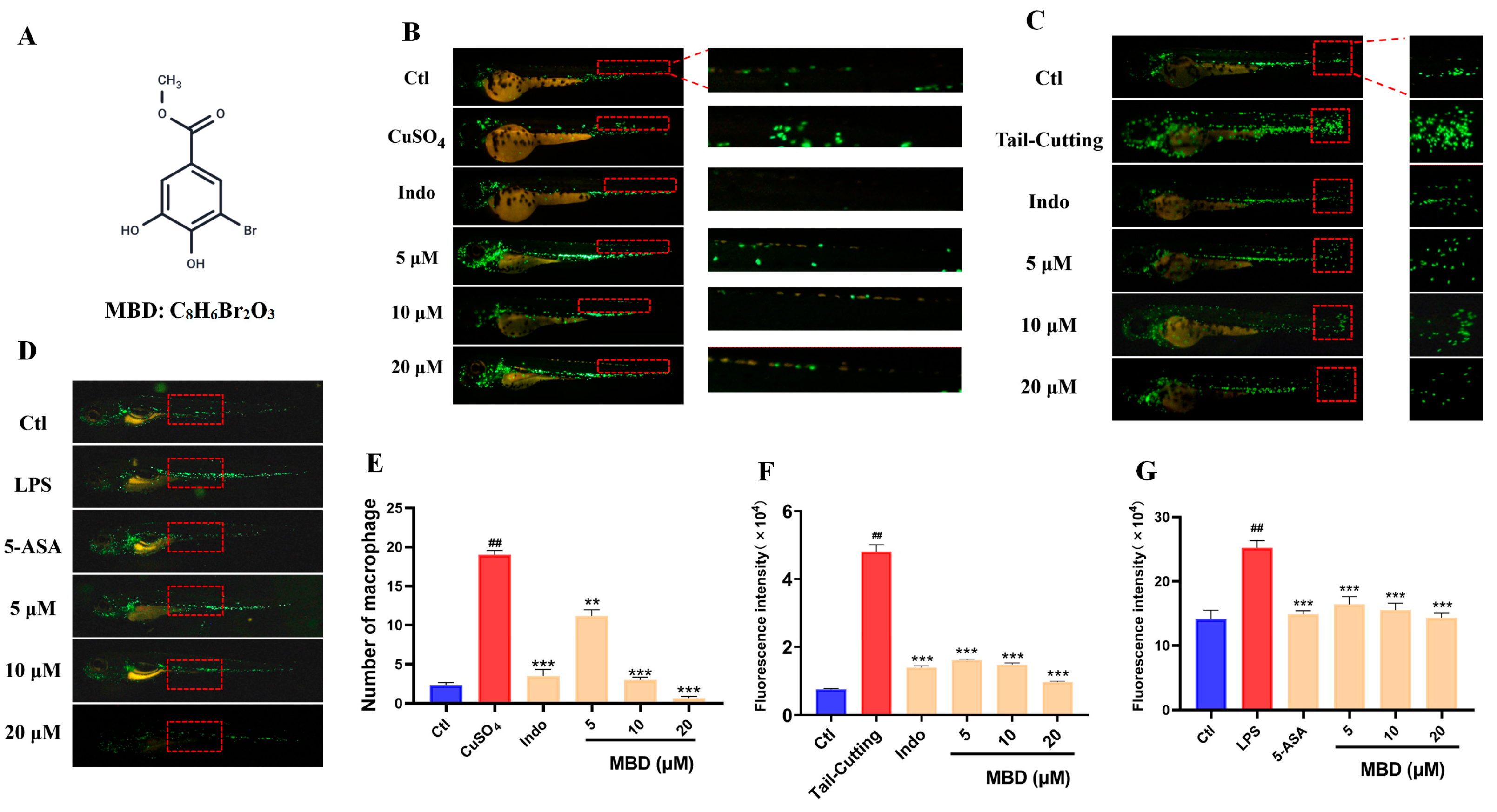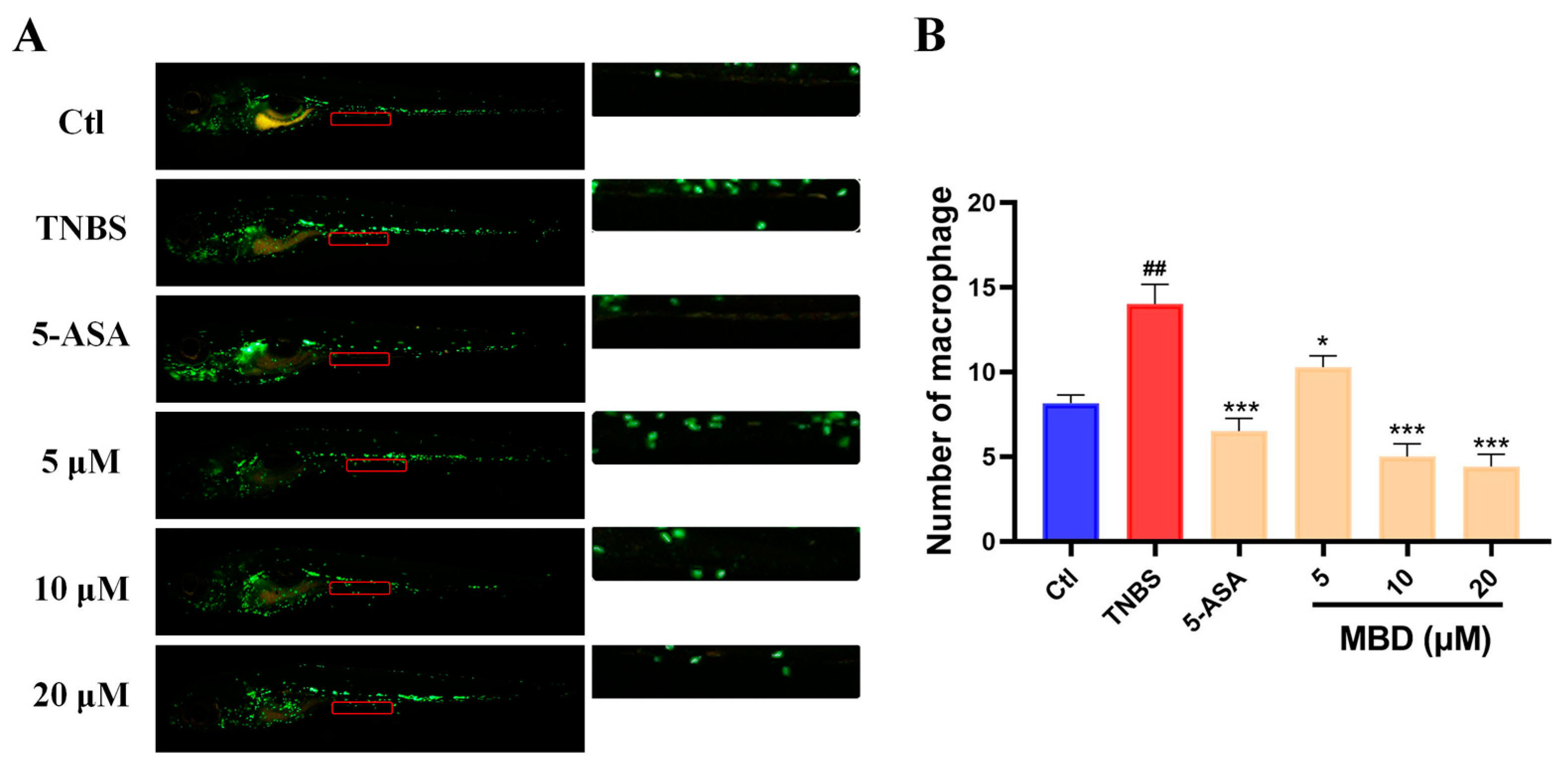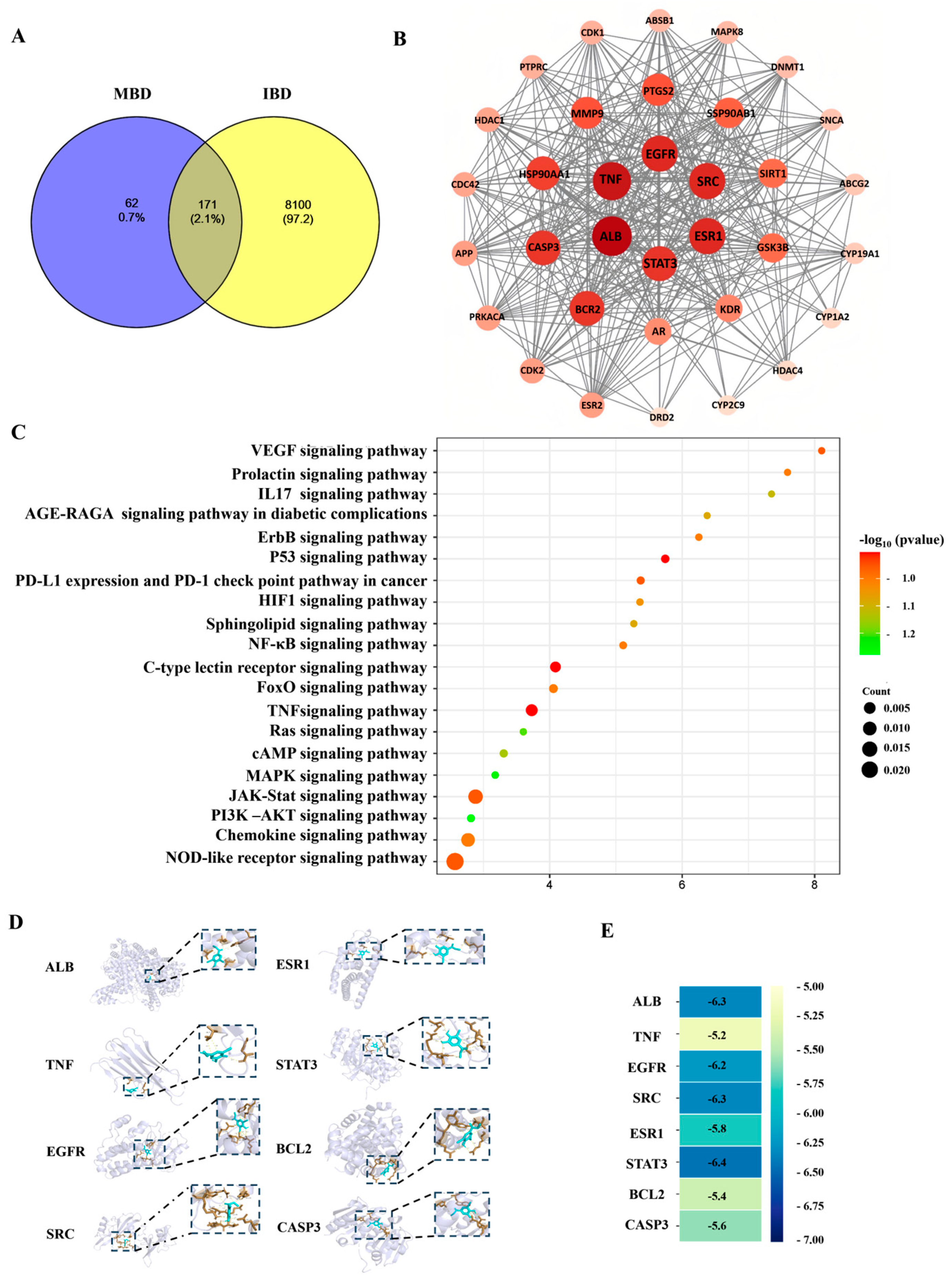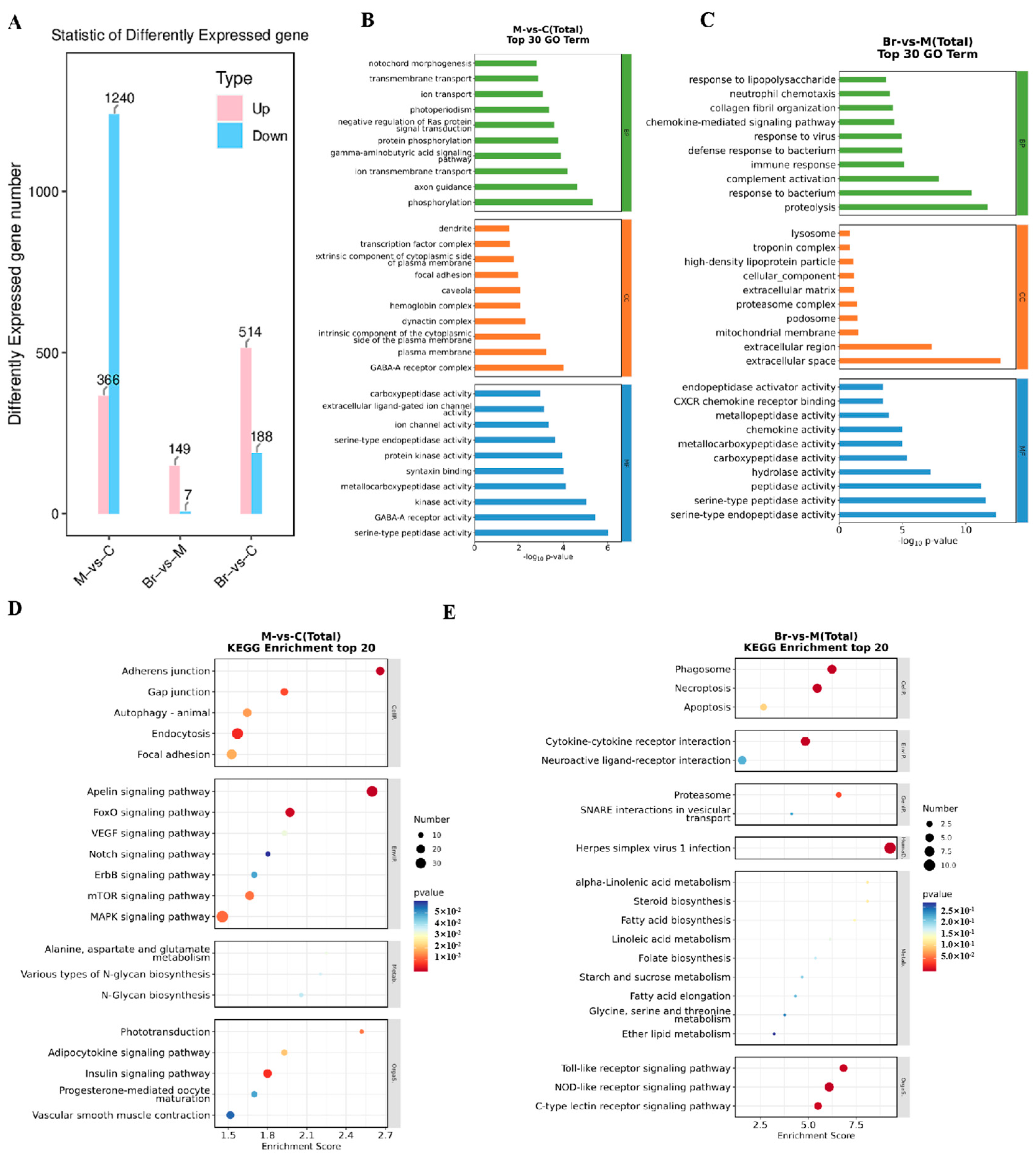Methyl 3-Bromo-4,5-dihydroxybenzoate Attenuates Inflammatory Bowel Disease by Regulating TLR/NF-κB Pathways
Abstract
1. Introduction
2. Results
2.1. The Activity of MBD Against Inflammation Induced by CuSO4, LPS or Tail-Cutting
2.2. MBD Relieved TNBS-Induced IBD
2.3. MBD Enhanced the Peristaltic Ability of the Intestine
2.4. MBD Enhanced the Integrity of the Intestinal Structure
2.5. MBD Reduced ROS Elevation Induced by TNBS
2.6. Network Pharmacology Analysis
2.7. Transcriptome Analysis
2.8. Gene Expression
3. Discussion
4. Materials and Methods
4.1. Zebrafish Strains and Culture
4.2. Chemical Reagent
4.3. Inflammation Induced by CuSO4, Tail Amputation, LPS or TNBS
4.4. Intestinal Efflux Efficiency Detection
4.5. Histopathological Analysis
4.6. ROS Analysis
4.7. Network Pharmacology Analysis Methods
4.8. Transcriptomic Analysis
4.9. Real-Time Quantitative PCR (qRT-PCR)
4.10. Statistical Analysis
Author Contributions
Funding
Institutional Review Board Statement
Data Availability Statement
Conflicts of Interest
References
- Smith, C. The potential of zebrafish as drug discovery research tool in immune-mediated inflammatory disease. Inflammopharmacology 2024, 32, 2219–2233. [Google Scholar] [CrossRef] [PubMed]
- Takada, L.T. Innate immunity and inflammation in Alzheimer’s disease pathogenesis. Arq. Neuro-Psiquiatr. 2017, 75, 607–608. [Google Scholar] [CrossRef] [PubMed]
- Ayoub, K.F.; Pothineni, N.V.K.; Rutland, J.; Ding, Z.; Mehta, J.L. Immunity, Inflammation, and Oxidative Stress in Heart Failure: Emerging Molecular Targets. Cardiovasc. Drugs Ther. 2017, 31, 593–608. [Google Scholar] [CrossRef] [PubMed]
- Singh, R.; Mishra, M.K.; Aggarwal, H. Inflammation, Immunity, and Cancer. Mediat. Inflamm. 2017, 2017, 6027305. [Google Scholar] [CrossRef]
- Meng, R.; Wu, S.; Chen, J.; Cao, J.; Li, L.; Feng, C.; Liu, J.; Luo, Y.; Huang, Z. Alleviating effects of essential oil from Artemisia vulgaris on enteritis in zebrafish via modulating oxidative stress and inflammatory response. Fish Shellfish Immunol. 2022, 131, 323–341. [Google Scholar] [CrossRef]
- Zhao, S.; Xia, J.; Wu, X.; Zhang, L.; Wang, P.; Wang, H.; Li, H.; Wang, X.; Chen, Y.; Agnetti, J.; et al. Deficiency in class III PI3-kinase confers postnatal lethality with IBD-like features in zebrafish. Nat. Commun. 2018, 9, 2639. [Google Scholar] [CrossRef]
- Pellegrini, C.; Fornai, M.; D’Antongiovanni, V.; Antonioli, L.; Bernardini, N.; Derkinderen, P. The intestinal barrier in disorders of the central nervous system. Lancet Gastroenterol. Hepatol. 2023, 8, 66–80. [Google Scholar] [CrossRef]
- Paone, P.; Cani, P.D. Mucus barrier, mucins and gut microbiota: The expected slimy partners? Gut 2020, 69, 2232–2243. [Google Scholar] [CrossRef]
- Florean, C.; Dicato, M.; Diederich, M. Immune-modulating and anti-inflammatory marine compounds against cancer. Semin. Cancer Biol. 2022, 80, 58–72. [Google Scholar] [CrossRef]
- Dong, H.; Dong, S.; Erik Hansen, P.; Stagos, D.; Lin, X.; Liu, M. Progress of Bromophenols in Marine Algae from 2011 to 2020: Structure, Bioactivities, and Applications. Mar. Drugs 2020, 18, 411. [Google Scholar] [CrossRef]
- Galasso, C.; Ruocco, N.; Mutalipassi, M.; Barra, L.; Costa, V.; Giommi, C.; Dinoi, A.; Genovese, M.; Pica, D.; Romano, C.; et al. Marine polysaccharides, proteins, lipids, and silica for drug delivery systems: A review. Int. J. Biol. Macromol. 2023, 253, 127145. [Google Scholar] [CrossRef] [PubMed]
- Fan, X.; Xu, N.J.; Shi, J.G. Bromophenols from the red alga Rhodomela confervoides. J. Nat. Prod. 2003, 66, 455–458. [Google Scholar] [CrossRef] [PubMed]
- Yadav, P.; Sarode, L.P.; Gaddam, R.R.; Kumar, P.; Bhatti, J.S.; Khurana, A.; Navik, U. Zebrafish as an emerging tool for drug discovery and development for thyroid diseases. Fish Shellfish Immunol. 2022, 130, 53–60. [Google Scholar] [CrossRef] [PubMed]
- Scholz, S. The zebrafish has become an attractive model organism in many areas of research ranging from basic developmental biology to applied toxicology. Reprod. Toxicol. 2012, 33, 127. [Google Scholar] [CrossRef]
- Astin, J.W.; Keerthisinghe, P.; Du, L.; Sanderson, L.E.; Crosier, K.E.; Crosier, P.S.; Hall, C.J. Innate immune cells and bacterial infection in zebrafish. Methods Cell Biol. 2017, 138, 31–60. [Google Scholar]
- Novoa, B.; Figueras, A. Zebrafish: Model for the study of inflammation and the innate immune response to infectious diseases. Adv. Exp. Med. Biol. 2012, 946, 253–275. [Google Scholar]
- Li, Z.; Li, M.; Li, D.; Chen, Y.; Feng, W.; Zhao, T.; Yang, L.; Mao, G.; Wu, X. A review of cumulative toxic effects of environmental endocrine disruptors on the zebrafish immune system: Characterization methods, toxic effects and mechanisms. Environ. Res. 2024, 246, 118010. [Google Scholar] [CrossRef]
- Belo, M.A.A.; Oliveira, M.F.; Oliveira, S.L.; Aracati, M.F.; Rodrigues, L.F.; Costa, C.C.; Conde, G.; Gomes, J.M.M.; Prata, M.N.L.; Barra, A.; et al. Zebrafish as a model to study inflammation: A tool for drug discovery. Biomed. Pharmacother. 2021, 144, 112310. [Google Scholar] [CrossRef]
- Liu, L.; Zhong, Y.; Zheng, T.; Zhao, J.; Ding, S.; Lv, J.; Xu, Q.; Zhang, Y. Epimedin B exerts an anti-inflammatory effect by regulating the MAPK/NF-κB/NOD-like receptor signalling pathways. Fish Shellfish Immunol. 2024, 150, 109657. [Google Scholar] [CrossRef]
- Renshaw, S.A.; Loynes, C.A.; Trushell, D.M.; Elworthy, S.; Ingham, P.W.; Whyte, M.K. A transgenic zebrafish model of neutrophilic inflammation. Blood 2006, 108, 3976–3978. [Google Scholar] [CrossRef]
- Zhou, H.; Cao, H.; Zheng, Y.; Lu, Z.; Chen, Y.; Liu, D.; Yang, H.; Quan, J.; Huo, C.; Liu, J.; et al. Liang-Ge-San, a classic traditional Chinese medicine formula, attenuates acute inflammation in zebrafish and RAW 264.7 cells. J. Ethnopharmacol. 2020, 249, 112427. [Google Scholar] [CrossRef] [PubMed]
- Morales Fénero, C.; Amaral, M.A.; Xavier, I.K.; Padovani, B.N.; Paredes, L.C.; Takiishi, T.; Lopes-Ferreira, M.; Lima, C.; Colombo, A.; Saraiva Câmara, N.O. Short chain fatty acids (SCFAs) improves TNBS-induced colitis in zebrafish. Curr. Res. Immunol. 2021, 2, 142–154. [Google Scholar] [CrossRef] [PubMed]
- Li, H.Y.; Liu, X.Z.; Chen, X.Y.; Qiu, Y.J.; Fu, J.R.; Sen, J.; Ran, Z.H. Application of Zebrafish Models in Inflammatory Bowel Disease. Front. Immunol. 2017, 8, 501. [Google Scholar]
- Zhang, Y.Z.; Li, Y.Y. Inflammatory bowel disease: Pathogenesis. World J. Gastroenterol. 2014, 20, 91–99. [Google Scholar] [CrossRef]
- Seyedian, S.S.; Nokhostin, F.; Malamir, M.D. A review of the diagnosis, prevention, and treatment methods of inflammatory bowel disease. J. Med. Life 2019, 12, 113–122. [Google Scholar] [CrossRef]
- Hall, C.; Flores, M.V.; Storm, T.; Crosier, K.; Crosier, P. The zebrafish lysozyme C promoter drives myeloid-specific expression in transgenic fish. BMC Dev. Biol. 2007, 7, 42. [Google Scholar] [CrossRef]
- Li, L.; Huang, J.; Feng, L.; Xu, L.; Lin, H.; Liu, K.; Li, X.; Wang, R. Altechromone A Ameliorates Inflammatory Bowel Disease by Inhibiting NF-κB and NLRP3 Pathways. Mar. Drugs 2024, 22, 410. [Google Scholar] [CrossRef]
- Ferro, J.M.; Oliveira Santos, M. Neurology of inflammatory bowel disease. J. Neurol. Sci. 2021, 424, 117426. [Google Scholar] [CrossRef]
- Loh, G.; Blaut, M. Role of commensal gut bacteria in inflammatory bowel diseases. Gut Microbes 2012, 3, 544–555. [Google Scholar] [CrossRef]
- Zhang, Z.; Zhao, L.; Zhou, X.; Meng, X.; Zhou, X. Role of inflammation, immunity, and oxidative stress in hypertension: New insights and potential therapeutic targets. Front. Immunol. 2023, 13, 1098725. [Google Scholar] [CrossRef]
- Chen, A.; Huang, H.; Fang, S.; Hang, Q. ROS: A “booster” for chronic inflammation and tumor metastasis. Biochim. Biophys. Acta Rev. Cancer 2024, 1879, 189175. [Google Scholar] [CrossRef]
- Liu, Y.J.; Xu, W.H.; Fan, L.M.; Zhang, Y.Q.; Xu, W.; Chen, Y.P.; Chen, L.L.; Chen, L.; Xu, W.; Wang, Y.; et al. Polydatin alleviates DSS- and TNBS-induced colitis by suppressing Th17 cell differentiation via directly inhibiting STAT3. Phytother. Res. 2022, 36, 3662–3671. [Google Scholar] [CrossRef] [PubMed]
- Zhang, P.; Zhang, D.; Zhou, W.; Wang, L.; Wang, B.; Zhang, T.; Li, S. Network pharmacology: Towards the artificial intelligence-based precision traditional Chinese medicine. Brief. Bioinform. 2023, 25, bbad518. [Google Scholar] [CrossRef] [PubMed]
- Noor, F.; Asif, M.; Ashfaq, U.A.; Qasim, M.; Tahir Ul Qamar, M. Machine learning for synergistic network pharmacology: A comprehensive overview. Brief. Bioinform. 2023, 24, bbad120. [Google Scholar] [CrossRef] [PubMed]
- Sabroe, I.; Parker, L.C.; Dower, S.K.; Whyte, M.K. The role of TLR activation in inflammation. J. Pathol. 2008, 214, 126–135. [Google Scholar] [CrossRef] [PubMed]
- Chou, W.C.; Rampanelli, E.; Li, X.; Ting, J.P. Impact of intracellular innate immune receptors on immunometabolism. Cell. Mol. Immunol. 2022, 19, 337–351. [Google Scholar] [CrossRef]
- Kumar, M.; Murugesan, S.; Ibrahim, N.; Elawad, M.; Al Khodor, S. Predictive biomarkers for anti-TNF alpha therapy in IBD patients. J. Transl. Med. 2024, 22, 284. [Google Scholar] [CrossRef]
- Hu, Y.; Jia, K.; Zhou, Y.; Chen, L.; Wang, F.; Yi, X.; Huang, Y.; Ge, Y.; Chen, X.; Liao, D.; et al. Rutin hydrate relieves neuroinflammation in zebrafish models: Involvement of NF-κB pathway as a central network. Fish Shellfish Immunol. 2023, 141, 109062. [Google Scholar] [CrossRef]
- Laurindo, L.F.; Santos, A.R.O.D.; Carvalho, A.C.A.; Bechara, M.D.; Guiguer, E.L.; Goulart, R.A.; Vargas Sinatora, R.; Araújo, A.C.; Barbalho, S.M. Phytochemicals and Regulation of NF-kB in Inflammatory Bowel Diseases: An Overview of In Vitro and In Vivo Effects. Metabolites 2023, 13, 96. [Google Scholar] [CrossRef]
- Hart, A.L.; Ng, S.C.; Mann, E.; Al-Hassi, H.O.; Bernardo, D.; Knight, S.C. Homing of immune cells: Role in homeostasis and intestinal inflammation. Inflamm. Bowel Dis. 2010, 16, 1969–1977. [Google Scholar] [CrossRef]
- Galván-Peña, S.; Zhu, Y.; Hanna, B.S.; Mathis, D.; Benoist, C. A dynamic atlas of immunocyte migration from the gut. Sci. Immunol. 2024, 9, eadi0672. [Google Scholar] [CrossRef]
- Xu, L.; Shi, Y.; Huang, J.; Feng, L.; Wang, Y.; Sik, A.G.; Chen, X.; Liu, K.; Wang, R.; Jin, M. Developmental toxicity assay of xanthatin in zebrafish embryos. Comp. Biochem. Physiol. C Toxicol. Pharmacol. 2024, 283, 109957. [Google Scholar] [CrossRef]








| Gene | Forward (5′-3′) | Reverse (5′-3′) |
|---|---|---|
| β-actin | AGAGCTATGAGCTGCCTGACG | CCGCAAGATTCCATACCCA |
| IL-1 | AGGTGCATCGTGCACATAAG | AAGCTGATGGCCCTAAACAG |
| IL-4 | GCCATATCCACGGATGCGACAA | GGTGTTCTTCGTTGCTGTGAGGA |
| IL-6 | TCTGCTACACTGGCTACA | ACATCCTGAACTTCGTCTC |
| NF-κB | CAATGAAATCTCCTGGGTG | CAATGAAATCTCCTGGGTG |
| TNF-α | ATGAGCACAGAAAGCATGATC | TACAGGCTTGTCACTCGAATT |
| STAT3 | CAGCAGCTTGACACACGGTA | AAACACCAAAGTGGCATGTGA |
| AP-1 | CCACCGCTCTCTCCTATC | ATCCTCTCCAGTTTCCTCTT |
| NLRP3 | AGCCTTCCAGGATCCTCTTC | CTTGGGCAGCAGTTTCTTTC |
| TLR3 | TTGCCTTGTATCTACTTTTGGGG | TCAACACTGTTATGTTTGTGGGT |
| TLR4 | AGACCTGTCCCTGAACCCTAT | CGATGGACTTCTAAACCAGCCA |
| MyD88 | ATCCACAGGGACTGACACC | CCACCACCATCCTCTTACAC |
| IκBβ | GGTGGAAAGACTCCTGAAAGC | TGTAGTTAGGGAAGGTAAGAATG |
| IKKβ | ACTCTCAGCTCAGTAAGACCG | CCACAGTCTTCTCATCCTCGTT |
| TRAF1 | GGGCAACCCAGACAAAGT | CATCGTGGAGGCTGAAGG |
| TRAF6 | GCCCATGCCGTAT | ACTGAATGTGCAGGGGACTG |
| NOD2 | TGCCTCGGGAACAGTAAGAC | GCCGCCCTCTCCATTAAAC |
| IFN-γ | CTCGTAAGACTCCTTGTGT | ATGAACTCGGTGAACTGG |
| Bcl-2 | TCACTCGTTCAGACCCTCAT | ACGCTTTCCACGCACAT |
| TGF-β | GAACTCGCTTTGTCTCCA | TACAGTCGCAGTATAACCTCA |
| TBX21 | CTCACCAACCATACCTCTC | TGTATTCGGTCTCGTAAGC |
Disclaimer/Publisher’s Note: The statements, opinions and data contained in all publications are solely those of the individual author(s) and contributor(s) and not of MDPI and/or the editor(s). MDPI and/or the editor(s) disclaim responsibility for any injury to people or property resulting from any ideas, methods, instructions or products referred to in the content. |
© 2025 by the authors. Licensee MDPI, Basel, Switzerland. This article is an open access article distributed under the terms and conditions of the Creative Commons Attribution (CC BY) license (https://creativecommons.org/licenses/by/4.0/).
Share and Cite
Huang, J.; Li, L.; Xu, L.; Feng, L.; Wang, Y.; SIK, A.G.; Jin, M.; Wang, R.; Liu, K.; Li, X. Methyl 3-Bromo-4,5-dihydroxybenzoate Attenuates Inflammatory Bowel Disease by Regulating TLR/NF-κB Pathways. Mar. Drugs 2025, 23, 47. https://doi.org/10.3390/md23010047
Huang J, Li L, Xu L, Feng L, Wang Y, SIK AG, Jin M, Wang R, Liu K, Li X. Methyl 3-Bromo-4,5-dihydroxybenzoate Attenuates Inflammatory Bowel Disease by Regulating TLR/NF-κB Pathways. Marine Drugs. 2025; 23(1):47. https://doi.org/10.3390/md23010047
Chicago/Turabian StyleHuang, Jing, Lei Li, Liyan Xu, Lixin Feng, Yuxin Wang, Attila Gabor SIK, Meng Jin, Rongchun Wang, Kechun Liu, and Xiaobin Li. 2025. "Methyl 3-Bromo-4,5-dihydroxybenzoate Attenuates Inflammatory Bowel Disease by Regulating TLR/NF-κB Pathways" Marine Drugs 23, no. 1: 47. https://doi.org/10.3390/md23010047
APA StyleHuang, J., Li, L., Xu, L., Feng, L., Wang, Y., SIK, A. G., Jin, M., Wang, R., Liu, K., & Li, X. (2025). Methyl 3-Bromo-4,5-dihydroxybenzoate Attenuates Inflammatory Bowel Disease by Regulating TLR/NF-κB Pathways. Marine Drugs, 23(1), 47. https://doi.org/10.3390/md23010047






